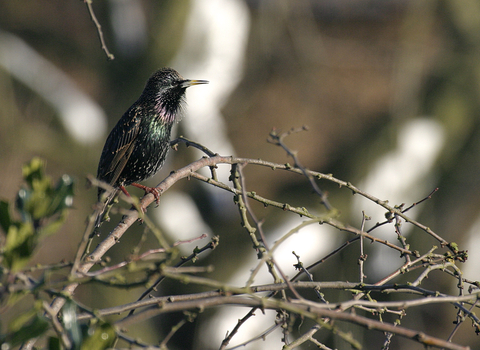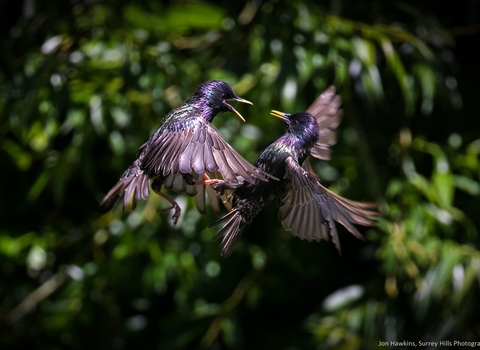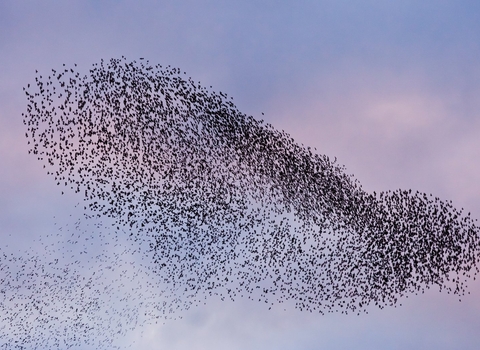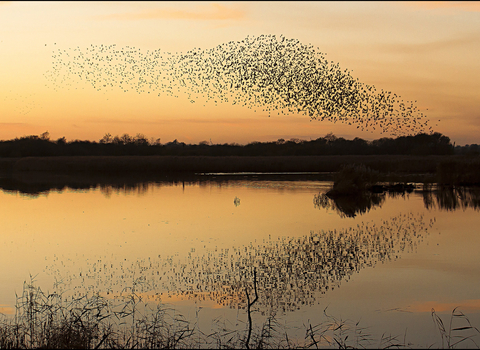
©Wildstock

Jon Hawkins, Surrey Hills Photography

A murmuration of starlings - Guy Edwardes/2020VISION
Starling
Scientific name
Sturnus vulgarisWhen to see
January to DecemberSpecies information
Statistics
Length: 22cmWingspan: 40cm
Weight: 78g
Average lifespan: 5 years
About
The starling is a familiar bird of farmland, parkland, gardens and towns. Sociable birds, starlings spend a lot of their time in large flocks, roosting and performing sweeping, aerial displays - they can often be seen moving fluidly through a wintry sky. starlings eat insects and fruit, and will visit birdtables and feeders. They make untidy nests in holes in trees or in buildings, in which the female lays five to seven eggs. Both parents raise the chicks.How to identify
Adult starlings are a beautiful, oily black colour, with a purple and green sheen. In the winter, they are covered in tiny beige spots. Young starlings are dark grey-brown.Distribution
Widespread.In our area
Starlings are often seen on farmland and in gardens across Shropshire. During the winter, large flocks of starlings gather to roost in the evening and form impressive murmurations in a few places around the county. As dusk arrives, the starlings set off for their communal roost in one of the most staggering natural spectacles of all. Flocks arrive from all directions, gathering in the skies above their roost sites. As the numbers reach into the tens and hundreds of thousands, the ‘murmurations’ (the name for a flying flock of starlings) take on incredible shapes in the sky, contracting and expanding as one flock merges into another, and taking on a life of their own; swirling back and forth in ever more complex and beautiful patterns.
One of the largest murmurations in the county takes place on the field edges of Whixall Moss, near Whitchurch. The bird hide at Charles Sinker Fields is an ideal place to watch the Whixall murmuration on some nights, but the show can sometimes move behind the hide and onto other fields depending on where the starlings decided to roost for the night.
Did you know?
Enormous winter flocks of starlings can number more than a million birds! These flocks are predated upon by peregrine falcons, but the flock can be seen wheeling and diving as one great pattern as individuals try to avoid being caught.Watch
Starlings (https://vimeo.com/453715689)
Starlings by Russell Savory
Starlings are often seen on farmland and in gardens across Shropshire. During the winter, large flocks of starlings gather to roost in the evening and form impressive murmurations in a few places around the county. As dusk arrives, the starlings set off for their communal roost in one of the most staggering natural spectacles of all. Flocks arrive from all directions, gathering in the skies above their roost sites. As the numbers reach into the tens and hundreds of thousands, the ‘murmurations’ (the name for a flying flock of starlings) take on incredible shapes in the sky, contracting and expanding as one flock merges into another, and taking on a life of their own; swirling back and forth in ever more complex and beautiful patterns.
One of the largest murmurations in the county takes place on the field edges of Whixall Moss, near Whitchurch. The bird hide at Charles Sinker Fields is an ideal place to watch the Whixall murmuration on some nights, but the show can sometimes move behind the hide and onto other fields depending on where the starlings decided to roost for the night.

